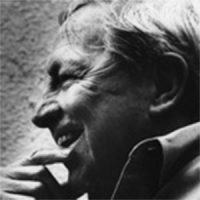

Robert Rauschenberg (1925-2008) was a painter, sculptor, and graphic artist known for helping to redefine American art in the 1950s and ’60s, providing an alternative to the then-dominant aesthetic of Abstract Expressionism. Rauschenberg realized his talent with drawing when he turned 22 in the Marines.
Born on October 22, 1925 in Port Arthur, Texas, “Robert” Milton Ernest Rauschenberg studied at the Kansas City Art Institute and the Académie Julian in Paris, before enrolling in 1948 at the legendary Black Mountain College in North Carolina. There his painting instructor was the renowned Bauhaus figure Josef Albers, whose rigid discipline and sense of method inspired Rauschenberg, as he once said, to do “exactly the reverse” of what Albers taught him.
More often, Rauschenberg’s early works reflected the aesthetic of his friend, composer John Cage, another member of the Black Mountain faculty, whose music of chance occurrences and found sounds perfectly suited Rauschenberg’s personality. The “white paintings’ produced by Rauschenberg at Black Mountain in 1951, while they contain no image at all, are said to be so exceptionally blank and reflective that their surfaces respond and change in sympathy with the ambient conditions in which they are shown, “so you could almost tell how many people are in the room,” as Rauschenberg once commented. The White Paintings are said to have directly influenced Cage in the composition of his completely “silent” piece titled 4’33” the following year.
In 1952 Rauschenberg began his series of “Black Paintings” and “Red Paintings,” in which large, expressionistically brushed areas of color were combined with collage and found objects attached to the canvas. These so-called “Combine Paintings” ultimately came to include such theretofore un-painterly objects as a stuffed goat and the artist’s own bedquilt, breaking down traditional boundaries between painting and sculpture, and reportedly prompting one Abstract Expressionist painter to remark, “If this is Modern Art, then I quit!” Rauschenberg’s Combines provided inspiration for a generation of artists seeking alternatives to traditional artistic media. (See Assemblage, Arte Povera.)
Rauschenberg’s approach was sometimes called “Neo-Dada,” a label he shared with the painter Jasper Johns, with whom he had a long artistic and personal relationship. Rauschenberg’s oft-repeated quote that he wanted to work “in the gap between art and life,” suggested a questioning of the distinction between art objects and everyday objects reminiscent of the issues raised by the notorious “Fountain” of Dada pioneer Marcel Duchamp. At the same time, Johns’ paintings of numerals, flags, and the like, were reprising Duchamp’s message of the role of the observer in creating art’s meaning.
By 1962, Rauschenberg’s paintings were beginning to incorporate not only found objects but found images as well–photographs transferred to the canvas by means of the silkscreen process. Previously used only in commercial applications, silkscreen allowed Rauschenberg to address the multiple reproducibility of images, and the consequent flattening of experience that that implies. In this respect, his work is exactly contemporaneous with that of Andy Warhol, and both Rauschenberg and Johns are frequently cited as important forerunners of American Pop Art.
Robert Rauschenberg, 1998
Photography y Sidney B. Felsen © 1998.
Website
http://www.rr-foundation.org/RRF